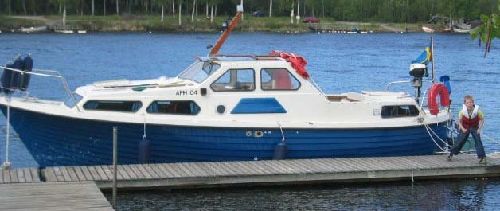Review of Karlø 28

Basic specs.

Looking for a new boat? Find a Karlø 28 or similar boat for sale
Both the hull and the deck is made of hand laid fibreglass. A hull made of hand laid fibreglass requires only a minimum of maintenance during the sailing season.
The deck is a sandwich construction which improves the indoor climate. Especially when the water is colder than the air in the cabin, then the double hull insulates against cold water and reduce the condense water in the cabin.
The boat is equipped with 2 cabins, 6 berths and 85 liters (22 US gallons, 18 imperial gallons) fresh water capacity.
The interior is like most other boats made of teak. Teak has the advantage of being naturally very oily and therefore water-repellent, which is suitable on boats.
The fuel tank has a capacity of 180 liters (47 US gallons, 39 imperial gallons).
The Karlø 28 has been equipped with different engine alternatives.
Alternative 1:
The boat may be equipped with an inboard Volvo Penta MD21A diesel engine at 75 hp (55 kW). The speed is 16.0 knots.
The transmission is a shaft drive. A shaft drive will in the long run require less maintenance than other types of drive e.g. a sail drive.
Alternative 2:
Karlø 28 may be equipped with an inboard Volvo Penta BB-30 diesel engine at 25 hp (18 kW). The speed is 12.0 knots.
The transmission is a shaft drive. A shaft drive will in the long run require less maintenance than other types of drive e.g. a sail drive.
Alternative 3:
The boat may be equipped with an inboard Perkins engine at 87 hp (64 kW). The speed is 15.0 knots.
The transmission is a shaft drive. A shaft drive will in the long run require less maintenance than other types of drive e.g. a sail drive.
Sailing characteristics
This section covers widely used rules of thumb to describe the sailing characteristics. Please note that even though the calculations are correct, the interpretation of the results might not be valid for extreme boats.
The immersion rate is defined as the weight required to sink the boat a certain level.
The immersion rate for Karlø 28 is about 161 kg/cm, alternatively 902 lbs/inch.
Meaning: if you load 161 kg cargo on the boat then it will sink 1 cm.
Alternatively, if you load 902 lbs cargo on the boat it will sink 1 inch.
Sailing statistics
This section is statistical comparison with similar boats of the same category. The basis of the following statistical computations is our unique database with more than 26,000 different boat types and 350,000 data points.
What is L/B (Length Beam Ratio)?
The l/b ratio for Karlø 28 is 3.11.
Curiosities
In Denmark, you are required to have achieved a 'powerboat driving license' in order to sail a powerboat.
In this context a boat is considered a powerboat if:

Danish definition of a powerboat
Though, if you install a motor of 77 kW (104 hp), then the boat will become a powerboat, and you will need a Danish 'powerboat driving license'
Maintenance
When buying anti-fouling bottom paint, it's nice to know how much to buy.
The surface of the wet bottom is about 22m2 (236 ft2).
Based on this, your favourite maritime shop can tell you the quantity you need.
Note: If you use a paint roller you will need more paint than if you use a paintbrush.
This section is reserved boat owner's modifications, improvements, etc. Here you might find (or contribute with) inspiration for your boat.
Do you have changes/improvements you would like to share? Upload a photo and describe what you have done.
We are always looking for new photos. If you can contribute with photos for Karlø 28 it would be a great help.
If you have any comments to the review, improvement suggestions, or the like, feel free to contact us. Criticism helps us to improve.
